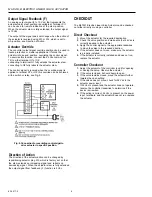
ML7421A,B ELECTRIC LINEAR VALVE ACTUATOR
63-2517-2
5
OPERATION
General
In the ML7421, the drive of a synchronous motor is
converted into the linear motion of the actuator stem by
using a worm gear transmission. A button retainer
clip connects the actuator stem to the valve stem.
The internal force sensor, using installed microswitches,
turns off the actuator when the specified stem force is
reached.
Manual Operation
The ML7421 is equipped with a manual operator knob (see
Fig. 7) to open or close the valve in the event of power
failure. Turn off or diconnect the power supply before
manuallly operating the ML7421.
To operate, push down the manual operator knob and turn
the knob counterclockwise to move the stem downward or
clockwise to move the stem upward. If the actuator is
returned to automatic control, the manual operator knob
unlocks automatically.
NOTE: If the manual operator knob is not pushed in while
turned, it turns only a short distance before it
automatically disengages without power resumption.
IMPORTANT:
Manual operation allows a very high closing force
that can jam the actuator spindle, exceeding the
rating of the force switches, and stopping the
motor.
After a manual valve close-off operation, release
the spindle one turn by turning the the manual
operator knob so the manual operator
automatically disengages on power resumption.
Auxiliary switches
The 43191680 Dual Auxiliary Switch can be used on both
the
ML7421A and ML7421B Electric Linear Valve Actuators.
Switching points are adjustable over the full length of the
actuator stroke; for example, the switch can be used to
switch pumps or to provide remote indication of any stroke
position. See the Installation Instructions packed with the
auxiliary switch.
IMPORTANT:
Use the 43191680 Dual Auxiliary Switch only with
24 Vac applications.
ACCESSORIES
Fig. 7. ML7421A,B manual operator knob.
Signal Input (+)
The analog input signal (+) range is set at the factory to 0 to
10 Vdc. Changing the position of the W2 selector plug sets
the range to 2 through 10 Vdc.
Changing the W4 position to mA (see Fig. 8.) the ranges are
0(4) to 20 mA. Selector plugs W1, W2, W3 and W4 are
positioned on the back side of the PCB protection sheet.
See Fig. 8 for location of the selector plugs.
2...10V
4...20mA
W2
0...10V
0...20mA
10V
20mA
W3
10V
20mA
mA
W4
V
W1 (W4 )
V
Fig. 8. Location of selector plugs W1, W2, W3 and W4.
Signal Input Failure
Using selector plug W1, the actuator can be set to run to
one of three positions in event of a signal failure:
1.
0% — Actuator position corresponds with 0 or 2 Vdc
signal
2.
50% — Actuator stem in mid-position
3. 100% — Actuator position according to 10 Vdc signal
NOTE:
W1 is factory set at 50% .
If W4 is set to mA-position, the actuator runs
always to 0% .


























